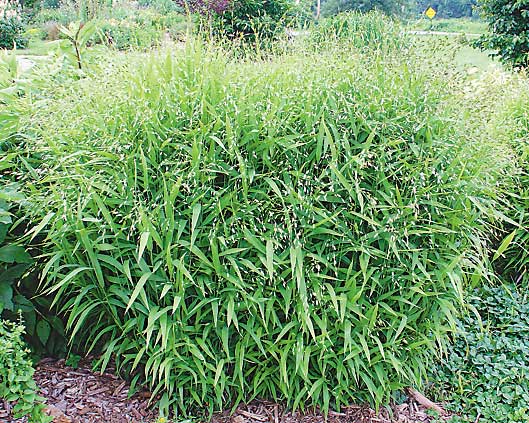Ornamental grass is a great addition to just about any landscape. Graceful ornamental grass clumps add delightful texture and interest to the garden in all seasons, they are incredibly easy to care for and there are hardy ornamental grass varieties suitable for any climate. Gardeners who are plagued with ravenous deer can also enjoy ornamental grass in their gardens as the plants are generally disliked by deer.

Questions people often have about ornamental grass are “when should the grass be cut back?” along with “how is it done?”
There are several opinions about when ornamental grass should be cut back once it flowers and becomes dry, and about as many opinions on how it should be done. One thing you need to know before cutting back the dry, dead stems of ornamental grass is whether the grass is a cool season or warm season grass. If you don’t know what variety of ornamental grass is in your yard, observing its growth habits will tell you whether it is a cool season or warm season grass.
Cool season ornamental grass begins to produce its new growth quite early in the spring, soon after temperatures begin to stay above freezing. Cool season grasses flower by early summer, making them good additions in the short growing season of a northern garden.
Warm season grasses begin to grow much later in the spring, sometimes so late that you may begin to wonder if they made it through winter. Warm season grasses begin flowering later in the summer and into the fall.
Some of the cool season ornamental grasses are fescue, ribbon grass (Phalaris), feather grass (Stipa), northern sea oats and tufted hair grass. Warm season ornamental grass includes both little and big bluestem, Japanese blood grass, maiden grass (Miscanthus), fountain grass (Pennisetum) and hardy pampas grass (Saccharum).
The spent flowers and seed heads of ornamental grass, along with the dried foliage, can add interest to the landscape throughout winter. Although the dead foliage of either cool season or warm season grasses can be cut back in late fall, many gardeners enjoy the beauty of the foliage throughout winter. Unless the plant becomes too shabby over winter, trimming back the dead stems of cool season ornamental grass can wait until the first balmy, late winter or very early spring day.
As soon as any snow melts and the ground begins to thaw, cool season grasses should be cut back. Waiting too long risks damaging the new shoots that will begin to emerge as soon as the weather begins to shift toward spring. Cut back cool season grasses so about a third of last year’s growth remains. Be careful to not cut back a cool season ornamental grass too far, as this can seriously harm the plant. Resist the temptation to burn off the dead foliage of a cool season grass, as this will also damage the growing tips. Don’t worry that these remaining dried stems will be unsightly, because the bright new spring growth will soon hide it nicely.
Warm season grasses can be left standing later into the spring while you take care of more urgent gardening tasks. Providing you don’t wait so long that the new foliage is already emerging, warm season grasses can be cut back to the ground. If you can already see some new green growth emerging as you prepare to trim the plant, just cut above it, being careful to not damage the new growth, otherwise all season long the plant will look like it has a crew cut.
Always wear heavy gloves and long sleeves while working with ornamental grass. The leaves on some, especially the Miscanthus varieties, can be very sharp and can quickly tear up your hands and arms. Wear eye protection as you cut the grass, to prevent bits of dried grass from getting into your eyes.
Ask a dozen experts and they’ll give you a dozen different methods for cutting back ornamental grass. Some suggest using a hedge trimmer, others say a grass trimmer with a blade rather than a nylon line will do the job effectively. There are those who use a curved pruning saw while others say a finely serrated bread knife is the right tool for the job. Any of those tools will work fine, but adding one more step will make the task, and the cleanup afterwards, much easier.
Tie a rope or wrap a bungee cord or two around the ornamental grass clump before cutting the dead foliage. Tie or wrap the grass tightly about two feet up from ground level, and then cut below the rope or bungee cord. Not only will this make the grass easier to handle as you cut it, but the entire bundle can then be carried away in one neat package.
If your ornamental grass is growing a bit too large for its space in the garden, you may want to divide the grass once it has been cut back. Smaller clumps can be dug out with a spade, but if the clump is rather large and unwieldy, power tools will simplify the job. Use a reciprocating saw with a ten-inch blade to cut down into the ground through the entire root system. Determine how many sections you want to get from the clump, then cut it up into sections with the saw. Then simply dig up the little squares and replant them to make more ornamental grass plants for your yard.
Mike McGroarty is the owner of McGroarty Enterprises and the author of several books. You can visit his website at FreePlants.com and read his blog at MikeBackYardNursery.com.
Related Articles & Free Email Newsletter
Gardening Tools for Raised Bed Gardens
Put Fall Leaves to Work in Your Landscape




Comment here